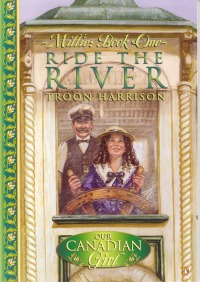| ________________
CM . . .
. Volume X Number 18 . . . . May 7, 2004
excerpt:
Thus ends Millie’s first trip outside of the city to the Kawartha lakes region of Ontario just as World War I breaks out. To her middle class Toronto mother’s consternation, Millie is not interested in embroidery and good manners, and when Millie’s antics become too much for a family with a new baby, she is shipped off for the summer. The vacation transforms her. Millie is introduced to an entirely different world when she visits her uncle, his Ojibwa wife and their son and daughter. Millie has never seen rural Ontario and is enthralled by the beauty of the lakes. She learns about the country way of living--which, for a child, includes work as well as play. She paints windows, carries groceries, canoes and swims. She is curious about her aunt’s heritage and discovers a whole other world, one where a woman does what is otherwise considered a man’s work and where races co-exist. Any mistaken preconceptions she has are cleared away as she becomes part of a loving family. She survives the tests her cousins present when she arrives, and they become close. She walks on logs, helps build a canoe and has other wondrous adventures she never would have dreamed of having. She returns home with regret but also with a sense of longing after so long away from her parents and baby sister. Ride the River provides a glimpse of Ontario resort areas when they were being developed as getaways through the steamboat system that ran up and down from Lake Ontario to Georgian Bay. The summer spawned a busy social season of regattas, dances and water sports. Edwardian society co-mingled with the aboriginal people who lived there. The book describes life from both sides of society at the time. Millie’s busy summer doesn’t allow for a lot of character development, especially before she leaves Toronto. The author is trying to provide a contrast between the middle class households which still had house servants and the self-sufficient pioneers on the lakes. She might have placed Millie on the riverboat right away recalling her Toronto life, to give her vacation characters more time to develop relationships. By doing so, her mother could have been less stereotypically impatient, and Aunt Mary could have been more than just a quiet Ojibwa woman. Nevertheless, Millie’s experiences educate the reader about life in a far gone era of Canadian history. World War I breaks out during the novel; when Millie heads home she will discover whether or not her father will be involved in the war effort, and what effect it will have on the family. That is sure to be the subject of future books about this tomboy who yearns for more than frilly dresses and femininity. Recommended. Harriet Zaidman is a teacher-librarian in Winnipeg, MB.
To comment
on this title or this review, send mail to cm@umanitoba.ca.
Copyright © the Manitoba Library Association. Reproduction for personal
use is permitted only if this copyright notice is maintained. Any
other reproduction is prohibited without permission.
NEXT REVIEW |
TABLE OF CONTENTS FOR THIS ISSUE
- May 7, 2004.
AUTHORS |
TITLES |
MEDIA REVIEWS |
PROFILES |
BACK ISSUES |
SEARCH |
CMARCHIVE |
HOME |
